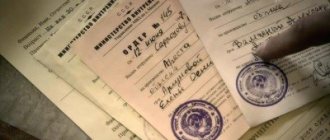VKontakte
When concluding a rental agreement for residential premises, each party reasonably wants to protect their interests and insure themselves in case of conflict.
A time-tested principle says: the more detailed the contract is, the fewer problems will arise during its execution. Therefore, a correctly compiled inventory of property is your faithful assistant when renting or renting an apartment.
Concept
An inventory of property refers to the process of listing items located on the territory of the premises being rented out and having material value, as well as the document itself, which is obtained as a result of such listing.
The main purpose of drawing up an inventory is to minimize the risk of disagreements between the tenant and the owner.
The completed inventory will be useful for both parties:
- the owner of the property, using an inventory, ensures the safety of the transferred property, and in the event of its damage or disappearance, receives evidence for compensation of losses;
- the tenant, in turn, as a result of drawing up such a document, insures himself against the fulfillment of unreasonable demands for the return or payment of what was not in the apartment at the time of delivery.
The document can be drawn up at the initiative of any party to the contract, the main thing is that the information entered corresponds to reality.
It is advisable to use one of the following options:
- The owner invites the future tenant to the apartment, and a list of transferred property is drawn up in his presence. This will help avoid disagreements regarding the availability, quantity and quality characteristics of the transferred property.
- The owner draws up the inventory individually, and when transferring the apartment for use, all described property is checked by the tenant for availability and condition. This option allows the tenant to save time.
Residential rental agreement
1.1. The Landlord transfers to the Tenant and the persons listed below: residential premises, which are: , located at the address: , consisting of: rooms, total area - sq.m., living area - sq.m., kitchen - sq.m., (hereinafter – “Object”) for temporary paid possession and use for residence.
2.3. The Lessor guarantees that at the time of signing this Agreement: it disposes of the Property on a legal basis - the document of law specified in clause 1.4 of this Agreement. The object is not leased, not alienated, is not under collateral, is not under arrest, and is not the subject of any dispute; the consent required by law from all owners and/or adult users of the Facility to conclude this Agreement has been obtained.
How to enter data when hiring?
The result of the transfer of transferred material assets when renting out an apartment is an act. It is a table describing the transferred items.
Before the table you need to indicate the address and characteristics of the apartment:
- room area;
- separation or adjacency of rooms;
- the presence of a loggia or balcony;
- the condition of the walls, floor and ceiling, finishing materials (for example, a suspended ceiling or a floor covered with parquet, as well as tiles on the wall should be reflected in the inventory);
- condition of the entrance and the presence of interior doors;
- other indicators that you consider important.
Let's move on to filling out the table:
- Name of property - pay attention to the correct indication of the name of the property to protect yourself from disagreements in the future.
- Quantity - usually in pieces. For single large items such as a sofa, it is not particularly important and is a purely formal indicator, but it will not hurt if you decide to record the number of silver teaspoons in the kitchen cabinet.
- Condition – excellent, good, satisfactory. The parameter is often subjective, but important for assessment.
Note: the tabular form is not strictly necessary and is used only for ease of use.
If it is more convenient for you to sketch out a list or create an inventory in the form of continuous text, it will also be valid. Therefore, the choice is yours.
Rental agreement for an apartment by a legal entity from an individual
The item details the address and characteristics of the apartment. Also in this paragraph it is necessary to refer to the certificate of ownership, on the basis of which the object belongs to a private person. It is assumed that at the time of signing the agreement, the parties familiarized themselves with the original documents for the apartment, each other’s passports, and the company’s constituent documents and were convinced of their authenticity.
It is important to keep in mind that the owner receives the monthly amount minus this tax. Therefore, it is preferable to indicate both the total price, the tax amount, and the difference. In any case, the individual does not pay any taxes - this is the responsibility of the organization, i.e. tenant.
How to draw up a condition for an inventory?
There are a few details worth paying attention to:
- In the rental agreement, include a clause stating that the property is transferred according to the inventory, which is an integral part of the agreement. This way you legally link the two documents into a single whole.
- In the inventory act itself, enter information that it is an annex to the rental agreement for residential premises (if your agreement is called that way) under such and such a number from such and such a date. This information should be written down either in the upper right corner of the document above the title, or immediately below the title of the act.
- If there is little property to be transferred, you do not need to draw up a separate document, but enter the list directly into the contract. Legally there is no difference, it is purely a matter of convenience.
Attention! If you decide to limit yourself to entering a list of valuables into the contract without drawing up a separate document, you should use the wording: “The specified property was transferred to the tenant before signing the contract, in connection with which the parties agreed to consider this clause at the same time an act of acceptance and transfer.”
However, more often the inventory is drawn up as an appendix to the contract, since with a detailed description of the transferred values it turns out to be quite voluminous.
In addition, the inventory can reflect the fact of the transfer of property (to the tenant when concluding the contract, and back to the owner when leaving), then this document will combine the functions of the inventory and the transfer and acceptance certificate.
Regardless of which option you choose, pay attention to the fact that the fact of transfer of property is recorded in one way or another.
How to fill out the application?
You can use the documents presented here:
Purpose of property inventory
A property inventory is a document that is used as an annex to a residential lease agreement. This document lists the property transferred to the tenant for temporary use along with the apartment. In some cases, an inventory of property may be included in the contract itself.
We advise you to read:
- ✅ How to draw up an agreement for renting an apartment to tenants?
- ✅ Certificate of acceptance of transfer of land: sample
- ✅ Agreement for free use of residential premises
- ✅ Lease agreement for non-residential premises
Considering that in most cases the rented premises are rented fully furnished and ready to move in, property damage can become a serious problem for the landlord. Moreover, this document allows you to protect the interests of the tenant, since any things, equipment, furniture tend to wear out or fail sooner or later.
An inventory of property allows you to minimize the likelihood of conflict situations that may arise when renting an apartment.
Naturally, it is in the owner’s interests to mention as many items remaining in the apartment as possible. Therefore, the inventory includes not only furniture, carpets and household appliances, but also dishes, linen, in a word, everything that is of value to the landlord. Those items that are not included in this list and are subsequently lost, damaged or misappropriated by the tenant will be almost impossible to return.
In addition to the inventory, this document contains two acts of acceptance and transfer of residential premises. The first act is filled out by both parties when renting out housing, the second - when returning the apartment to the landlord.
Nuances of the procedure for renting out residential premises
When compiling a list of property, it is worth considering the following:
- The document, like the contract, is drawn up in 2 copies, one for each party. If the apartment was found through a realtor, then a third copy of both documents may be required.
- Make sure that the contents of all copies are absolutely identical, so as to subsequently protect yourself from finding out whose copy corresponds to reality.
- When describing the condition of each item, you need to take into account the possibility of its natural wear and tear. This is especially true for returning things to the owner when leaving the apartment. It is common for any thing to lose its new characteristics over time, and this must be taken into account. Normal wear and tear refers to those changes that a property undergoes during normal use during the lease term.
- When drawing up an inventory, you should immediately provide in the contract how events will develop in the event of damage or destruction of the described property by the tenant. Will he be obliged to pay the owner a fixed amount, or will compensation for damage be calculated based on the value of the damaged item? It is better to agree on all these points on the shore.
Inspection algorithm
When inspecting an apartment, you should establish the availability and evaluate the quality of the property in as much detail as possible.
Step by step plan:
- Property located in the apartment - sofas, carpets, tables - assess the general condition and appearance.
- Electronics and household appliances - refrigerator, microwave, TV - check operation.
- Sockets and switches - inspect for serviceability.
- Plumbing - check the work and appearance, make a note in the inventory about possible leaks, chips of enamel, etc.
- Kitchen stove - turn on each burner, oven and evaluate performance.
- Dishes, small household items - check quantity and condition.
- Meters - carefully inspect the seals, make sure they are intact, record the meter readings.
Rental agreement for an apartment by a legal entity from an individual
It is important to keep in mind that the owner receives the monthly amount minus this tax. Therefore, it is preferable to indicate both the total price, the tax amount, and the difference. In any case, the individual does not pay any taxes - this is the responsibility of the organization, i.e. tenant.
The item details the address and characteristics of the apartment. Also in this paragraph it is necessary to refer to the certificate of ownership, on the basis of which the object belongs to a private person. It is assumed that at the time of signing the agreement, the parties familiarized themselves with the original documents for the apartment, each other’s passports, and the company’s constituent documents and were convinced of their authenticity.
List of criteria for describing existing items
- appearance;
- quantity;
- colors;
- defects: their presence, nature and severity;
- working or non-working condition;
- year of manufacture (for household appliances);
- brand of equipment;
- price.
Note: You have the right to indicate the price of the transferred items. In the event of damage, it will be easier to calculate its size and, accordingly, the amount of compensation.
But be reasonable: you should not indicate a deliberately disproportionate cost if you are the owner. And as a renter, pay attention that the owner of the apartment does not inflate the price of things that you will use.
PRO new building 7 (499) 450-27-46 (Moscow)
- Rent amount. Landlords must receive remuneration. The amount must be expressed in rubles.
- Detailed description of the object. The main requirement is the availability of accurate information that allows one to identify a particular object. The cadastral passport is a mandatory attachment.
- The parties must also indicate their full details in the document. It is especially important to indicate intermediaries if they are involved in the transaction.
- Purchase of several non-residential properties when the goal is similar.
- Regularly making trades at approximately the same time.
- Acquisition of real estate for the purpose of making a profit or selling it during use.
- Stable connections with tenants on an ongoing basis.
- Preparation of accounting documents for transactions and operations.
- Receipt of cash income on a regular basis as a result of the use of real estate.
We recommend reading: When Buying an Apartment from a Developer What to Pay Attention to
Are there requirements for the form of the document?
The main requirement for an inventory is ease of use. The law does not limit either the content, structure, or method of creating such a document: it can be a table printed from a computer, or a list of items written by hand on a sheet of paper. The main thing is that the list contains the signatures of both parties.
Using an inventory is an effective way to regulate the relationship between the tenant and the apartment owner regarding the transferred property. It is worth spending the time and effort to compile it, and you will save yourself from possible problems.
If you find an error, please select a piece of text and press Ctrl+Enter.








